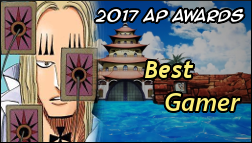@TARIPAR:
Let's. Freakin'. Go. :D
:D
:D
EDIT: Also, I noticed you guys are going with "Ara" instead of "Ala." Is the official Romaji ARABASTA? I've also noticed that "Reverie" (Levely) hasn't been updated to reflect the manga yet.
These google docs keep track of romanizations and the logic of why certain names are used:
Reference Guide
Usually the name that’s romanized most in the original Japanese version of the manga wins unless it’s inconsistent or else wouldn’t conform to certain rules of thumb when it comes to translation. These are the general guidelines:
-
We generally favor American English when considering subtitle terms. All terms must conform to general English rules when it comes to capitalisation and spelling. This includes series terms and titles. Contractions can be used.
-
Character names/unique object names are never translated.
-
Titles, types of objects, event names, group names and most nicknames are translated.
-
Location names (usually in Kanji) are always translated unless the pronunciation is given in kana, in that case stick with a romanization of the kana. (if it is a katakana representation of an english word make adjustments if necessary).
-
Onomatopoeia are never written out.
-
Attack names are generally left translated unless it would ruin a pun/reference.
-
Any dialogue in a language other than Japanese can be left in said language.
-
Any Japanese term that has been adopted into English doesn’t have to be translated but it should be written with the standard romanization (Geisha, Sushi, Karate, Samurai ect).
-
Any Japanese term that has cultural/historical references that would be lost if translated can be kept in Japanese under some circumstances.
-
Honorifics are to be kept untranslated unless they are redundant. (Like Master-sama would just be master). Names are to be kept in the Japanese order, Surname before the given name. Measurements are generally to be kept in the units originally presented.
-
Romanization from the author are to be used unless they contradict any of these rules. If there is a dispute then go with the romanization that makes the most sense meaning wise or is used the most.
-
Sentence structure must generally be reordered to SVO to sound more natural.
-
Exceptions can be made to these principles under certain circumstances. E.G. the admiral code names.
So for example “Mugiwara” is romanized a few times in colour spreads and the like, but that’s ignored because it violates rule 2. Issues that appear to be spelling mistakes are also amended like Gurdiams to Guardians. Whenever it’s trying to mimic an existing word there is something to reference.
Recently Road Poneglyph was updated to Lode Poneglyph to better reflect the reference to Lodestar. Some things like that and Laugh Tale have hidden meanings that don’t become apparent for years, so it makes no sense to tie oneself to popular terms that are less reflective of the meaning. A lode is like a guiding point in Middle English, the North Star is a Lodestar and you find out you need them on Lodestar Island.
Levely doesn’t mean anything as far as I can discern, so at the moment there is no clear reason to change Reverie other than romanization, which could be a mistake. Since that example is unclear an exception was made specifically for it.
Here is a google doc documenting Arabasta’s romanizations and arguments specifically.
Arabasta and Alabasta are used interchangeably by Oda in the original manga. This is because L and R are the same letter in Japanese. Ara is used more recently but with how inconsistent he’s been in the past it’s better to look at other official Japanese sources and dig into the route arguments behind each name. Ara is by far and away used most in other Japanese mediums, from the anime to guidebooks, colour walk, dvd cases, manga compilations, the site ect. It also reflects the intended puns more directly.
The setting is based on the Arabian peninsula. (At least the modern parts, the more ancient underground parts are specifically Egyptian, while the modern cities and fashion reflect post Islamic styles in the region). Even the food and climate match.
There is a popular fan theory about alabaster stone being a potential reference but that is also represented by the “bast” part of Arabasta, if you assume it’s a portmanteau. Alabasta only reflects the second potential reference and that reference is far less obvious/ direct.
The fan base has been split on it for years and more recently Alabasta has been popularised by the official English adaptations but they occasionally make odd decisions like Zolo, so I think it’s best not to tie oneself to the subjective interpretations of one countries’ localisation when it’s a global effort. When it’s this inconsistent it’s best to look at other primary sources and try and go with the option that makes the most sense in a vacuum.
While I think this approach results in a more accurate/ fitting result, I appreciate that some people will always prefer what they’re used to and that’s cool. Sometimes like with Raftel change takes time or else it’s just up to the individual what they use.
However, for a project like this, I think it’s best to just examine each term as it comes and evaluate their merits to come to the best outcome you can.








 .
.